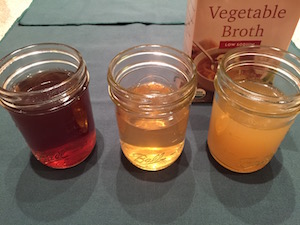
by plant4health | Feb 27, 2015 | Plant-based, Recipes, Vegan
Vegetable broth is handy to have on hand for making rice dishes, risotto, and soups. It’s convenient to buy at the store but be sure to look carefully at the ingredients. Some list carrots as the first ingredient and the broth can be orange in color and very sweet. Some manufacturers such as Whole Foods brand add a bit of sugar and oil which is best to avoid. Trader Joe’s Organic Hearty Vegetable Broth has carrots as the first ingredient but does not add sugar or oil. Try a few brands to see what you prefer.
Of course the best broth is what you make from scratch. It’s not difficult, just takes a bit of advanced planning. But it’s worth it. You can control how intense you want the flavors to be and design it for the dish you are making.
A time-saving (and money-saving) tip is to save clean vegetable trimmings in a gallon freezer bag as you are cooking other meals or making salads. You can use theses scraps that would otherwise get composted to make broth. Save onion and shallot peels and the ends of leeks and green onions; carrot and potato peels, ends of celery (and their leaves), chard stems and bell pepper. In a separate bag save mushroom ends. You’ll add the mushrooms if you want a darker, earthier flavor, especially if you are making a mushroom risotto. You can also add fennel which will give a licorice flavor. Avoid cruciferous veggies such as broccoli and cabbage as they will add a bitter taste. Red beets will turn it red.
You can make a broth using just the scraps plus herbs (see recipe below) or add additional vegetables which you can roast or sauté first if you want a more intense flavor. Here is a wonderful basic broth recipe from Anna Thomas, featured on Epicureous.
For a broth just from the scraps, use this recipe from thegardenofeating.org:
- Place 4-6 cups of scraps in a soup pot or dutch oven and add
- 1 bay leaf
- 3-5 cloves of garlic, peeled
- 4 branches of Italian parsley
- A sprig of thyme or 1 teaspoon dried thyme
- Cover with water, about an inch above the veggies, bring to a boil and simmer uncovered for about 45 minutes.
- Strain the broth through a colander lined with cheesecloth or a strainer.
If not using the broth right away, let it cool completely and freeze it in a freezer-proof container or ice cube trays, or store for up to five days in the refrigerator.
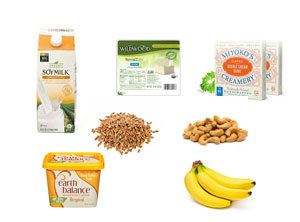
by plant4health | Feb 20, 2015 | Plant-based, Vegan, WFPB, Whole food, plant-based
One of the fun adventures in transitioning to a whole food, plant-based (WFPB) vegan lifestyle is experimenting in the kitchen by learning how to modify recipes. Here are some suggestions to get you started.
Milk
- Instead of using cow’s milk in recipes, simply substitute plant milk such as almond, coconut, hemp, or soy in a 1:1 ratio.
- You can also make your own cashew milk by combining 1 cup cashews with 4 cups water in a high speed blender, such as a Vitamix. For best results, soak the cashews in water for 4 hours or overnight prior to blending.
- You can use this same recipe for making almond milk, but you’ll definitely need to soak the almonds overnight and then strain through a nut bag.
Buttermilk
- Add 1 Tablespoon apple cider vinegar to 1 cup non-dairy milk
Cream
- Cashews also make a great cream substitute. Just use less water than when making milk. Mix 1 cup cashews with 1/4 to 1/2 cup water and blend. Start with less water and add more until you get your desired consistancy. You can add a sweetener such as maple syrup, a bit of sea salt and natural vanilla extract to add flavor and sweetness.
Sour cream
- Use plain soy yogurt instead of sour cream
Butter
- Use olive oil or coconut oil instead of butter, or buy a vegan butter such as Earth Balance. It uses organic (non-GMO) palm fruit, soybean, canola and olive oils.
- You can also use almond butter instead of oil or butter when baking cookies.
Mayonnaise
- Try vegan mayonnaise such as Hampton Creek’s Just Mayo which uses non-GMO expeller-pressed canola oil, lemon juice and white vinegar as key ingredients.
- You can also use a mashed avocado or guacamole, hummus or baba ganoush on sandwiches instead of mayo.
Cheese
- Use nutritional yeast flakes instead of cheese in recipes such as risotto.
- Tofu is also a great substitute for ricotta cheese in lasagne. I like to blend soft tofu in the food processor with a bit of fresh spinach, garlic and onion powder plus salt and pepper for a tastey ricotta.
- There are some fantastic vegan cheeses that are coming onto the market. Recently I tried Miyoko’s Creamery Double Cream Chive cheese which is made from organic, non-GMO cashews, coconut oil, chives, chickpea miso and other ingredients. It is wonderful as an appetizer served with crackers or a sliced baquette, grapes or apple slices.
Eggs
- In baking, good egg substitutes include banana, applesauce, or soft tofu.
- You can also use ground flax or chia seeds. Mix 1 Tablespoon ground seeds with 2 Tablespoons water and let sit for a bit.
- You can also buy Ener-G Egg Replacer which is made from potato starch, tapioca flour and levening agents.
- For making scrambled eggs, substitute tofu, such as in our tofu scramble recipe. You can also use tofu in quiches and custard and eggless “egg salad” sandwiches.
Gelatin
Stock / Broth
- For soups or making risotto, use a vegetable broth instead of chicken or beef stock
So have fun experimenting with your favorite recipes and let us know if you have other tips or suggestions for vegan substituions.
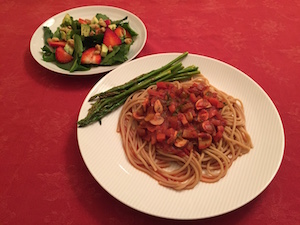
by plant4health | Feb 11, 2015 | Nutrition, Plant-based, Recipes, Vegan, WFPB, Whole food, plant-based
Here are three great reasons for cooking a whole food, plant-based meal for your special someone this Valentine’s Day.
- Heart-healthy
Research has proven that a whole food, plant-based (WFPB) diet consisting of vegetables, fruits, grains and legumes can improve and even reverse heart disease. A study published in the July 2014 issue of The Journal of Family Practice, called “A Way to Reverse CAD” (Coronary Artery Disease), found that 81% of study participants improved their symptoms and 22% experienced a complete reversal of their condition. Since there is no cholesterol in plants and low saturated fat, people on a plant-based diet tend to have lower cholesterol numbers as well as lower blood pressure than those who consume meat and dairy products. Source: PCRM. So you can feel good about serving a meal that will help your heart, and your partner’s, beat longer and stronger.
(more…)

by plant4health | Feb 6, 2015 | Plant-based, Vegan, Vegan restaurants
-

-
Happy Cow photo at Wild Cow in Nashville
-

-
Pear, spinach salad at Millenium in SF
-

-
Grilled tofu with rice and veggies at Wild Cow in Nashville
-

-
Mike Gospe enjoying a taco sampler at Wild Cow in Nashville
I was a vegetarian for 18 years before I became a vegan in 2010. Once I cut out dairy, I realized just how much cheese is in restaurant fare – on salads, over pasta, on pizza, etc. Over the years, I’ve learned to plan ahead, explore new restaurants and not hesitate to ask wait staff for their assistance in selecting vegan-friendly menu items. Here are some tips that I’ve learned…
Friends & Family:
When dining at a family member’s or friend’s home: (more…)
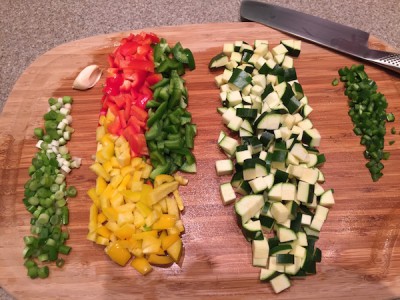
by plant4health | Jan 29, 2015 | Nutrition, Plant-based, Vegan, Whole food, plant-based
In response to many requests for detailed information on how to eat a low glycemic alkaline diet to reverse disease, we have developed this Healing with Food: Menu Guide. We’ve experienced first hand how focusing on nutrition, alkalizing the body, and eating only whole plant-based foods reverses cancer. Read our story.
Our website has many wonderful resources about the benefits of a plant-based diet and the importance of balancing your pH during the healing process and in maintaining perfect health.
We’d love to hear from you about your experience eating a plant-based diet. Contact us to share your story.
Follow our blog and join us as we learn how to be healthy from the inside out.
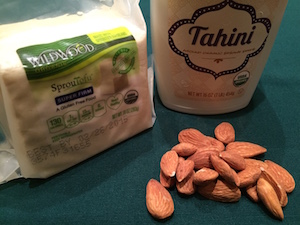
by plant4health | Jan 26, 2015 | Nutrition, Vegan, WFPB, Whole food, plant-based
The second question vegans are asked, after “where do you get your protein,” is usually “so what about calcium? Don’t you need milk products for that?”
Just as we can get all the protein we need from whole food plant-based (WFPB) sources, we can also get all the calcium we need.
Calcium, an alkaline earth mineral, is a building block of teeth and bones and is important in signaling cellular processes. Long-term calcium deficiency can lead to osteoporosis (thinning of the bones), rickets (weakening of the bones) and a reduction in the blood’s ability to clot.
We have grown up thinking that the best sources of calcium are milk, cheese, yogurt, etc. However, many research studies show that the countries in which dairy consumption is the highest, also have the highest incidence of osteoporosis and hip fractures. Dairy products (and meat) create acid in our bodies. Our bodies then pull calcium from our bones, which is highly alkaline, to neutralize the acid, resulting in calcium loss.
It’s important to not only consume calcium (via plant-based sources), but to prevent it from being leached from your bones. Other than eating an alkalizing diet, the Physicians Committee for Responsible Medicine, PCRM.org, recommends limiting salt to 1 to 2 grams per day (since it increases calcium loss via the kidneys), limiting alcohol (since it reduces your body’s ability to build new bone) and not smoking. In addition, it’s important to do weight-bearing exercises (like walking, running, hiking, and lifting weights), and to get enough Vitamin D (see below).
The Recommended Dietary Allowance (RDA) of calcium for adults is 1,000 to 1,200 mg per day and 1,300 mg for pregnant or lactating women.
Plant-based sources of calcium include leafy green vegetables, legumes, nuts, seeds, fortified plant milks and fortified orange juice.
Magnesium is also a building block of bones. The RDA for magnesium ranges from 400-420 mg for adult men and 310-400 mg for adult women. Here are some plant-based foods with the amounts of calcium and magnesium per serving:
| Food |
Calcium
|
Magnesium |
| Tofu 1/2 c. made with calcium sulfate |
861 mg |
73 mg |
| Orange Juice (calcium fortified) 1 cup |
349 mg |
27 mg |
| Soy milk (calcium fortified) 1 cup |
200-300 mg |
32 mg |
| Collard greens, cooked 1 cup |
268 mg |
40 mg |
| White beans, 1 cup cooked |
161 mg |
113 mg |
| Dried figs, 10 each |
136 mg |
57 mg |
| Tahini (ground sesame seeds) 2 TB |
128 mg |
28 mg |
| Chick peas /garbanzo beans 1 cup canned |
109 mg |
61 mg |
| Swiss chard 1 cup cooked |
102 mg |
152 mg |
| Kale 1 cup cooked |
94 mg |
23 mg |
| Almonds 1/4 cup |
94 mg |
304 mg |
| Sweet potato, 1 cup boiled |
76 mg |
54 mg |
| Broccoli |
62 mg |
33 mg |
Vitamin D is essential for calcium absorption. Our bodies make Vitamin D through exposure to the sun. So many of us have grown up fearing skin cancer and slather our bodies with sun screen. But 10-15 minutes of sun on our bare skin in the morning or late afternoon is beneficial. As we age, our bodies are not as effective at producing Vitamin D from the sun. And foods, even plant-based, may not be enough. Have your Vitamin D level checked by your doctor and take a D3 supplement as recommended. The RDA for Vitamin D in adults is 600-800 IU.
Sources:









